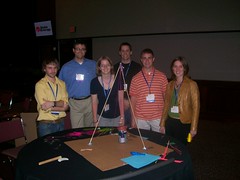Each table got a box of stuff - two thin dowels, a role of twin, some rubber bands, a plastic cup. a small plunger, springs, zip ties, a coil of wire.... and so on, with a small marble. The goal was to create a contraption that would keep the marble moving longest after starting it off. You could release it, but not push it, to start. There were a number of rules (more on that later) to limit what you could or couldn't do. Our table came 2nd.
We went with a simple pendulum supported by a bipod held in place with guy-wires. We suspended the cup and filled it with as much mass as possible. Finally, we put the plunger head upside down in the top of the cup with the marble - the shape of this surface was conducive to keeping the marble moving and wobbling even if the pendulum was slowing down.
Now for the rules - and the pedagogical value. The rules were designed to be simple. They defined what "moving" meant to avoid typical engineer arguments like the earth is always moving so the marble is too - or Brownian motion, etc. They also did not allow the contraption to be fastened to the table. (Some groups feel we ran afoul when we held our box with the endorsement of the judge - they were probably right!) These rules were quite clear an unambiguous. Less clear was the guidance on the size/footprint of the system.
As the instructions were given to us, we were told to fold our box flat and put it on the table - this was the footprint our system had to fit into. Some groups, including ours, took that to mean that the system must be built upon the flattened box. Others just assumed that any system that was smaller than the size of the flattened box was OK and that the box was available to be used as part of the building materials.
At least two pedagogical lessons:
- sometimes rules are vague - you have to interpret them for yourself
- diversity of opinions can lead to better design

No comments:
Post a Comment